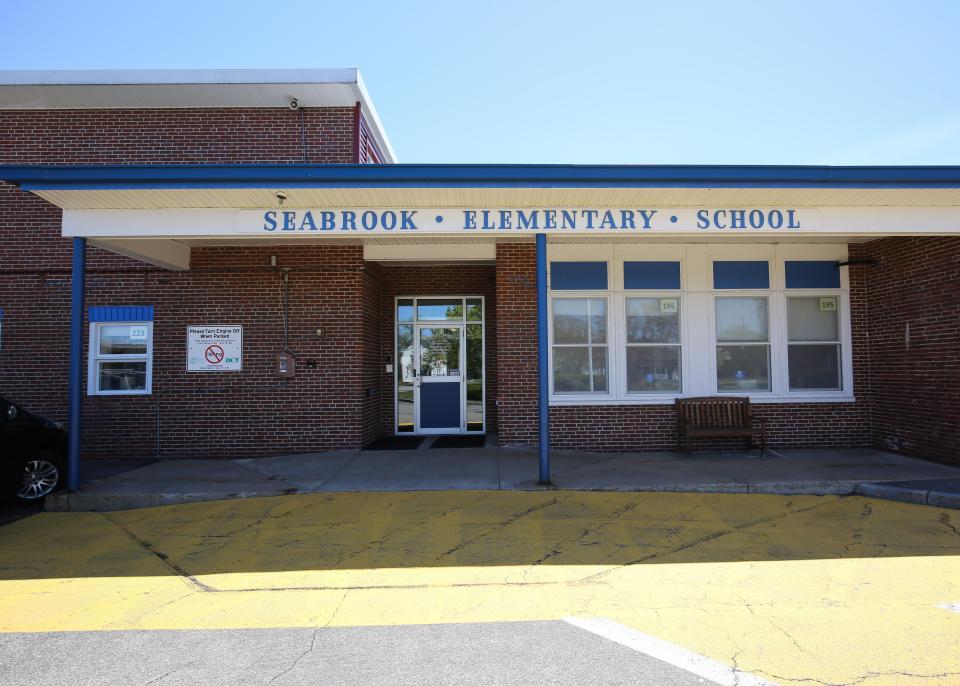Seabrook School Board votes to explore leaving SAU 21: Here's why and what's next
SEABROOK — The town’s School Board plans to ask voters to form a committee to determine whether Seabrook should withdraw from School Administrative Unit 21.
The board voted 4-1 to start the formal process of breaking away from the SAU consisting of Hampton Falls, North Hampton, South Hampton and the Winnacunnet Cooperative School District.
The motion, made by School Board member Kelli Hueber and seconded by member Jennifer Hubbard, came at the end of the Nov. 14 School Board meeting.

According to the draft meeting minutes, the motion popped up without prior discussion on the topic from board members, nor was it on the agenda.
SAU 21 Superintendent Meredith Nadeau said the issue of withdrawing from SAU 21 had been a “standing agenda item” in Seabrook for the first year of her tenure.
Nadeau said she hadn’t been notified before the meeting the issue would come up.
Seabrook School Board Chairwoman Christina Keiser, who voted against the motion, said she was also unaware that a motion would be made. However, she noted the board had discussed the issue on and off in 2021.
Nadeau said she didn't know what the specific cause of concern was that led to the vote as there was little discussion on the motion at the meeting. However, she acknowledged there have been continual concerns about student achievement, as well as budgetary costs over the years.
“The board is responsible for looking out for the community, and one way to do it is to use taxpayer resources wisely,” Nadeau said. “They’re not wrong to want a better education for their students.”
Will Hampton follow suit? North Hampton approves cell tower to fix Route 1 dead zone
Why would Seabrook withdraw from SAU 21?
Keiser believes those who voted for the motion Nov. 14 each have their reasons and didn’t want to speculate on what they were.
“Our goal as School Board members is to do what we feel is best for the kids in our community,” Keiser said.
Keiser said she didn’t feel it was appropriate to discuss why she voted against forming a committee to study possible withdrawal.
“The motion was passed,” Keiser said, “and I believe my role should be to work together with the board members to move forward on it.”

In recent years, Seabrook parents have repeatedly expressed concern about the students' lack of proficiency in academics, according to annual state achievement test scores.
Further, many parents have expressed anxiety when students, who have earned good grades during their Seabrook school years through middle school, find themselves behind their peers academically from other communities at Winnacunnet High School.
The most recent state student assessment scores have not alleviated those concerns. According to a snapshot of the 2023 spring assessment scores for Seabrook students, scores indicate an average of 30% of students in the third and fourth grades were at or above proficiency in language arts, and 35% were at or above proficiency in math.
For middle schoolers, this spring’s testing indicated an average of 34% of sixth through eighth graders were at or above proficiency in language arts and 21% at or above in math.
Seabrook has also seen several leadership changes in recent years. Most recently the town's middle school witnessed the resignation of its principal Jamie Parsons, who gave notice less than a month before school started this fall. Nadeau took over as principal until interim Principal Colleen Lennon was hired.
More: Molly St. Jeanne, owner of Big Bad Food Truck, to lead Hampton Holiday Parade
Not the first time Seabrook has considered breaking up with SAU 21
More than a decade ago, a voter-approved feasibility study committee recommended the town remain in SAU 21. One of the primary reasons was the cost involved in establishing its own SAU was estimated to be higher than what it would be if it remained in SAU 21.
At the time, however, Hampton was still part of SAU 21.
Hampton voters approved withdrawing from SAU 21 and formed SAU 90 on July 1, 2011. Supporters of Hampton’s withdrawal effort argued that Hampton paid the lion's share of the SAU 21 budget but didn’t get much in return.
Like Hampton, if Seabrook does withdraw, it would continue to send students to the high school as part of the Winnacunnet Cooperative District.
Game changer? Seabrook PD gets nearly $1M grant to combat opioid crisis
Seabrook withdrawal could be costly for SAU 21
After Hampton withdrew from SAU 21, Seabrook became the town with the largest student population in SAU 21 and the second largest sending students to Winnacunnet behind Hampton.
In its elementary and middle schools alone, Seabrook has about 650 students, while South Hampton K-8 population is about 85, Hampton Falls approximately 180, and North Hampton around 300.
Because of that, Nadeau said, Seabrook currently pays 29.42% of SAU 21's annual budget, and 30.52% of the Winnacunnet budget. Hampton provides about 50% of the high school's annual budget, according to Nadeau.
Because of its student population and related budgetary responsibility to SAU 21, if Seabrook voters eventually approve the withdrawal, the result would significantly impact the remaining towns in the SAU, according to Nadeau.
“We’d have to reexamine our operations,” Nadeau said.
Seabrook board vote is first step in the withdrawal process
Keiser plans to reach out to the SAU’s legal counsel to ensure the relatively complicated withdrawal process, as outlined in state statute, is followed. She couldn’t estimate how long that would take, nor if a warrant article requesting voter approval to form a planning committee for a feasibility study to withdraw from the SAU will be on the Seabrook School District’s March 2024 warrant.
According to the state statute, school board members have the authority to vote to create a planning committee to study issues — such as withdrawal from a district — and then place that question on the school district’s warrant for voters to decide. School district voters have the “final authority to adopt the provision to create a planning committee,” according to the RSA.
If voters approve the committee, the RSA specifies its membership, how and when it meets, the issues it must investigate, what’s to be included in its report, and how to go about developing a plan to create a new SAU, should it recommend withdrawal. Although the members stipulated by the statute must serve without pay, the RSA does allow funding to be attached to the question to underwrite the cost of such an in-depth investigation.
In the end, should voters first approve the formation of a withdrawal committee and a recommendation to withdraw forthcoming, the new SAU plan must again go before voters. A three-fifths (super-majority of 60%) of voters must approve. Should it fail, it can be brought up again the next year. Should it fail a second time, it cannot be brought before voters again for at least two years.
This article originally appeared on Portsmouth Herald: Seabrook School Board votes to explore leaving SAU 21

